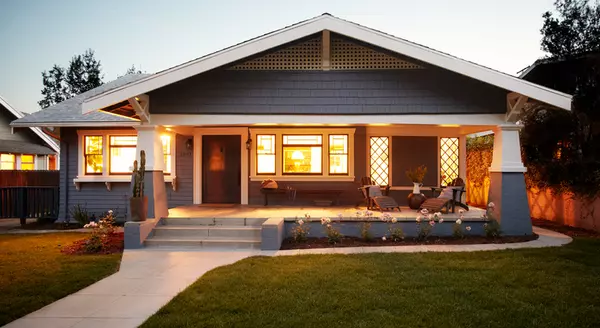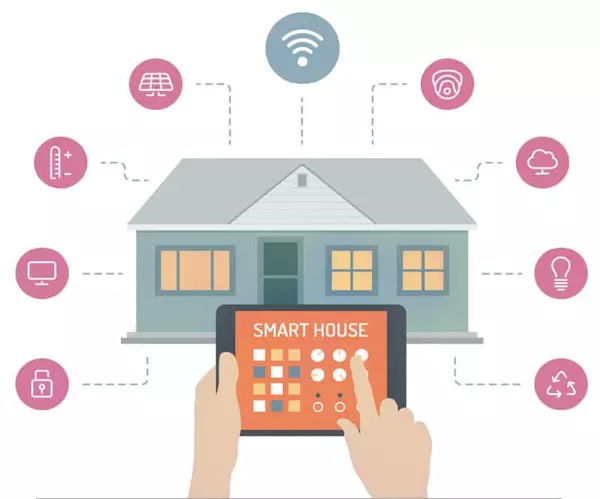Smart Home Security Gets Even Smarter — and Easier
Smart home security can give you a (virtual) lock on protecting your home and peace of mind.
Once upon a time, installing a smart home security system was complicated and expensive. To get one, you had to call a professional company. They’d send an installer out to drill holes in your walls and run wires throughout your home. You’d spend big bucks for the installation and a multiyear maintenance and monitoring contract.
But now, technology has changed that completely. You can DIY a smart home security system with moderately priced equipment. Your options include smart door locks, security cameras, video doorbells, and motion sensors you can install yourself. Smart home security systems run on Wi-Fi, Zigbee, or Bluetooth, with no wiring needed. And you can monitor these systems with an app on your phone.
Because of this simpler, more affordable technology, home security devices are more popular. Market researchers NPD Group report that half of U.S. consumers now own at least one smart home device, up from 35% in 2020. And smart security devices are one of the most popular smart home devices. They had higher sales gains, at 44%, than any other category in 2020, says NPD Group.
If you’re thinking of joining the fan club by adding smart home security to your house, here’s an overview of the most popular device categories.
Smart Door Lock
A smart door lock is a Wi-Fi- or Bluetooth-enabled device that lets you lock and unlock a door via an app on your phone. Smart locks work by opening and closing a deadbolt electronically. This form of keyless entry lets you open a door with an icon tap or a voice command. That way, you won’t be fumbling for keys while your arms are full of groceries.
Pros
You have a lot of control over comings and goings at your house. You can see who opened the smart door lock and when, so you can check if your kids got home from school on time. You’ll know if the dogwalker showed up at noon. And you can do it while sitting at your desk at the office. “I love knowing every time my door opens or closes,” says Christy Roth, a smart home tech expert in charge of Home & Distribution Software and Devices at Schneider Electric in Spring Hill, Tenn.
You can give out virtual keys. These codes will let a guest or family member unlock the door with their phone. You can set the keys to expire or work only during specific times. You won’t have to leave a key under the doormat or give away house keys you won’t get back.
Burglars can’t pick them. Smart locks don’t have a key slot, so they’ll foil analog burglars.
Cons
If you lose power or your phone, you may not be able to get into your house. If you don’t have power you won’t have Wi-Fi. And that means you can’t open your smart lock. The same chain of events happens when you lose your phone. You need a backup plan, like being able to log into your smart lock from another device. It’s the digital equivalent of a spare key.
They use batteries. If the batteries die, you won’t be able to unlock the door. You must change the batteries periodically.
Digital thieves can hack them. They can try to override your entry code and unlock your door. The good news: Your lock will alert you that there’s been an unauthorized entry.
They’re more expensive. Smart locks cost $150 to $300, significantly more than a dumb lock.
Video doorbell
A video doorbell lets you see who’s at your door when you’re not home. The device, also called a doorbell camera, uses Wi-Fi to stream live video to your phone. Here’s how it works: When someone rings the doorbell or when the camera detects motion, an app will notify you. The video doorbell will then livestream video to your phone so you can speak to the person at the door. You can record the video and save it to your phone or the cloud, which comes in handy if you want a record of who did what on your porch. “A video doorbell is a must-have in my book,” Roth says. A lot of people agree. As of 2020, about 20 million U.S. homes,16%, had video doorbells. Industry analysts predict that number will grow significantly as more people adopt smart home technology.
Pros
You can answer the door wherever you are. Whether you’re on the other side of the door or the other side of the world, you can see who is at your door and ask them what they want.
They help stop porch pirates. Roughly 36 million Americans say they’ve had packages stolen from their porch in the last year. When a delivery person leaves a package, a video doorbell will alert you so you can bring it inside or tell the person where to stash it. If porch pirates beat you to your package, a video doorbell can help police catch the thieves because you’ll have them on camera stealing your Amazon Prime delivery. “If someone knows you’ve got a video doorbell, they’ll probably think twice about stealing your package,” says Steven Hummel, manager of the Consumer Technology Association’s market research team. “They add a lot of security to your home for not a lot of money.”
You don’t have to rush to the door every time the bell rings. Instead, check the app on your phone. If it’s a friend, get off the sofa and let them in. If it’s a stranger, you don’t have to interrupt your “Ted Lasso” binge.
Cons
Some video doorbells need to be hardwired to your existing doorbell wiring. That may not not be a DIY job, since you’d have to handle electrical wires.
Some run only on batteries. They’re easier to install, but you’ll need to replace the batteries every few weeks.
They’re more expensive than a dumb doorbell. Video doorbells cost $100 to $350, depending on the features. That’s as much as eight times the cost of an analog doorbell.
Some companies try to upsell you on a confusing array of services and features. You can hook your device up to a 24/7 monitoring center or get more storage space in the cloud by paying extra fees. “I can’t tell you how many $1.99 and $4.99 services many of these devices come with,” Roth says. “It can get overwhelming managing and understanding the services you need versus the ones you don’t.” If you know your needs, that will help you sort through which, if any, additional services to get, Roth adds. If you’re a regular online shopper, consider a package detection upgrade that some video doorbells offer. It will alert you when a delivery person picks up or drops off a package. Or you can opt for a basic paid subscription that lets you store, download, or share video for up to 60 days.
Motion Sensor
A smart motion sensor is a battery-powered device that detects when anything or anyone crosses its path and triggers an action. It communicates over Z-Wave, Zigbee, Wi-Fi, or Bluetooth. A motion sensor can do everything from turning on lights when you enter a room to telling you when your toddler is climbing out of her crib. A lack of motion can also trigger motion sensors, so lights will turn off when no one is in a room. You can run motion sensors through an app on your phone to control devices including smart lights and speakers just by tapping an icon.
Pros
You can install motion sensors easily and almost anywhere. You can mount them on the wall or set them on a flat surface in minutes.
Motion sensors can lower your energy bills. A motion sensor can tell smart bulbs, smart speakers, and TV sets to turn off when a room has been empty too long or at a set hour each night.
You can use them to turn a houseful of smart home gadgets into a smart home. Place motion sensors around your home, link them to your smart devices via your smart speaker, and the sensors can help everything work together.
They’re super affordable. You can get a motion sensor for as little as $20.
Cons
Motion sensors use batteries. You’ll need to check and change them regularly to keep them working. Most will let you know when the batteries are getting weak.
If they run on Wi-Fi, they may hit dead zones in your home and stop working. You’ll need to boost their range with a mesh router – also called a mesh network – that pairs two or more routers together to deliver a seamless Wi-Fi network. If your home is larger than 3,000 square feet or multistory, a mesh router is a good idea. A bridge – a device that joins two or more Wi-Fi networks so they can work as a single network – will also boost your home’s Wi-Fi coverage.
Security Kit or Home Monitoring System
If you want your DIY smart home security to go bigger than one or two devices, get a security kit. Also known as a home monitoring system, these kits replace the home alarm systems you used to have a pro install. They generally come with contact and motion sensors, a base station that’s the wireless brain of the system, and touch-screen control panels.
Pros
You can customize the system. Adding security cameras, glass break sensors, panic buttons, and environmental sensors will alert you to gas leaks, water leaks, or fire.
You can integrate your other smart tech devices. Many home security systems double as smart home hubs so you connect and automate your other smart devices into a single network. You can connect your alarm, your smart locks, your smart thermostat, and your video doorbell and run them all with an app on your phone.
You can save money on homeowners insurance. Some insurance companies give policy discounts for homes with security systems that include window and door sensors, smart locks, or video doorbells. They don’t give discounts for individual devices like video doorbells.
The kits are more affordable than professionally installed alarm systems. Home monitoring systems start at $200 to $400 for a basic setup.
Cons
You will have to pay extra for professional monitoring. Unlike professionally installed alarm systems, you don’t get a team of trained dispatchers who will monitor your alarm 24/7. That’s part of the reason DIY systems are so much more affordable. Many home monitoring systems offer professional monitoring for an extra monthly fee that ranges from $10 to $40.
You’re the tech support. Unlike professionally installed systems, there’s not a tech on call to fix glitches. It’s just you and You Tube tutorials.
Smart tech security devices make it easy and affordable to protect your home. You can install many of these devices yourself and only pay for a monitoring plan when you want it. You can keep an eye on your family and your home from any location via sensors and cameras directly from your phone. Video doorbells, smart door locks, motion sensors, and home monitoring systems put high tech security at your fingertips.

![Your Homebuying Adventure [INFOGRAPHIC]](https://img.chime.me/image/fs/chimeblog/20231209/16/w600_original_5fa69e75-cebc-430f-95c7-a1662a2ec57f-png.webp)




![3 Reasons To Sell Your House Before the New Year [INFOGRAPHIC]](https://img.chime.me/image/fs/chimeblog/20231202/16/w600_original_64cef848-fc6d-4f30-ba53-0c799b3a5a27-png.webp)






